
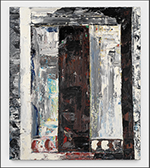
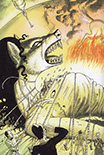
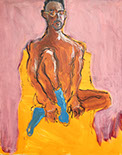
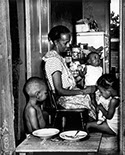
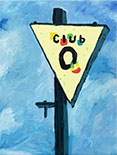

“Centered” at Engage Projects
Two Views of Today’s Feminism in Art
by Michel Ségard
When you enter Engage Projects’s gallery space, you are confronted with two rows of “abstract paintings.” On the left, are five works by Jean Alexander Frater, and on the right, hang a row of 12 pieces by Margaret Welsh. The two rows seem to be carrying on a dialogue between each other. First, yes, they are abstract; but no, they are not paintings in the traditional sense.
Starting with Frater’s pieces. Better described as constructions, they are made from strips of torn canvas that she had previously painted as hard-edged abstractions. Frater carefully rearranges the strips to create a new abstract image. This technique creates a relief surface that gives them a sculptural quality. One of them, Hitching Belt, actually has an element that projects into the room by about a foot. Several of her pieces are also irregularly shaped. Most notably, Stretched inward and outward not only has a hole in the middle, but has a bent side, making the piece roughly five-sided. Turquoise Field is a corner piece spanning two walls with an irregular bottom.

Jean Alexander Frater, (Left) Hitching Belt, 2022. Acrylic and latex on torn canvas then woven, 40 x 40 inches.
(Right) Stretched inward and outward, 2022. Acrylic and latex on torn canvas, 30 x 40 inches. Photos courtesy Engage Projects.
The other notable technical aspect of Frater’s work is the texture that the torn canvas strips create. Their edges are a little frayed and, of course, mostly unpainted. So, there are fine white lines that permeate the work, tending to push the pieces into the realm of fiber art. But this is no ordinary fiber art; the strips are very carefully placed to create new images and, in Turquoise Field, even result in an ombré field. Since the strips are narrow (about one inch wide), the pieces begin to take on a pixilated look, tying them into our digital age. In Hitching Belt, the strips are pulled apart in the middle, making the work feel a little like a curtain. But there is a limit to this technique. There are a couple of small works, less than a foot square, in which the strips are too big for the pieces, and they end up looking bulky and ragged.
Hard edge abstraction that flourished in the mid 20th century was an “all-male” endeavor. Here we have a woman who takes on that aesthetic and “feminizes” it. As a result, Frater’s works has an androgynous aspect. They challenge the strict feminism of the past with a more subtle and epicene point of view. (The resulting dialogue reminded me of Irving Berlin’s song “Anything You Can Do I Can Do Better” from the musical Annie Get Your Gun.)
Margaret Welsh has a completely different approach. Her pieces are also assemblies made from painted materials. All twelve pieces have an identical format. The base of each piece is a paper drop cloth painted with a single shade of house paint and folded up into an approximately 18-inch square. Roughly in the middle of each piece is a pink strip about two inches wide running down from top to bottom. The assembly is then bound by a string tied horizontally across the middle, creating four quadrants. All twelve pieces, each a different color, are displayed in a row along one wall of the gallery. Welsh has painted each drop cloth with a color that she has equated with a skin tone. She has called them: latte, very light olive, chestnut, spiced almond, alabaster, warm silk, truffle, mahogany, cocoa, peachy, porcelain, and deepest almond. Each piece is named Trophy Woman followed by one of the colors in parentheses.

Margaret Welsh, Trophy Woman (Latte, Warm Silk, Cocoa, Chestnut, Alabaster, Peachy, Mahogany, Deepest Almond, Porcelain, Truffle, Very Light Olive, Spiced Almond), 2023. House paint on paper drop cloths, mounted to panel with string.
But why 12 iterations? The pieces are conceptually identical, varying only in background color and slightly in size as a result of the drop cloth folding process. Formally, the 12 pieces are not different enough to be viewed as a series in the traditional sense. There is no formal or conceptual progression from one piece to the next. So, they are conceptually perceived as one piece; yet they are offered for sale separately. What is disconcerting is that, because of the lack of conceptual progression from one piece to the next, the content of the work would be just as clear with six pieces. Repetition needs a reason that a viewer can perceive for it to be effective.

Margaret Welsh, the last six segments of Trophy Woman. Photo courtesy Engage Projects.
The vertical pink strip immediately stands out in each of Welsh’s pieces. It carries a definite connotation of female genitalia. The string tied around the middle also creates a waist of sorts. These “brown paper packages tied up with strings,” as the song goes, end up giving off a very feminine aura—but not as a favorite thing. It is an aura of being confined, restrained, stifled. Welsh’s work can be interpreted to be a feminist statement about the continued confinement of women artists to certain “womanly” niches in the art world.
Therein lies the dialogue between these two sets of works. Facing one another across the gallery, Welsh bemoans the constraints put upon her by a male-dominated artworld. While across the room, Frater takes the “womanly” niche of fabric art and turns it on its head, creating pieces that would be traditionally thought of as masculine. It is an interesting discussion to be having through the medium of works of art in this age of gender fluidity and the continued assault on women’s rights.
Michel Ségard is the Editor in Chief of the New Art Examiner and a former adjunct assistant professor at the School of the Art Institute of Chicago. He is also the author of numerous exhibition catalog essays.
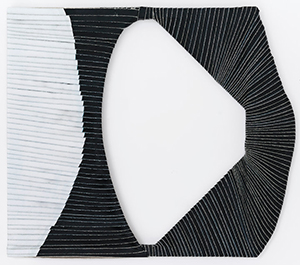
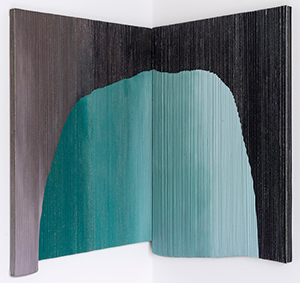
Jean Alexander Frater, Turquoise Field, 2022. Acrylic and latex on torn canvas then woven, two 48 x 36 inch panels. Photo courtesy Engage Projects.